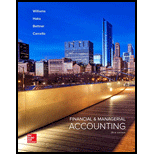
Concept explainers
a.
Allocate the utilities cost pool to each product line assuming by assuming deluxe model used as 6,400 machine- hours and the basic model used 1,600 machine-hours.
a.
Answer to Problem 10BE
Calculate the utilities cost pool for each product line:
| Particulars | Utilities Cost Allocated |
| Deluxe | $144,000 |
| Basic | $36,000 |
| Total cost allocated | $180,000 |
(Table 1)
Explanation of Solution
Calculate the utilities cost pool to each product line assuming by assuming deluxe model used as 6,400 machine- hours and the basic model used 1,600 machine-hours.
| Particulars | Machine hours | Percent to total |
| Deluxe | 6,400 |
|
| Basic | 1,600 |
|
| Total | 8,000 | 100% |
(Table 2)
Working note:
Calculate the percent of deluxe model machine hours:
Calculate the percent basic model machine hours:
b.
Allocate the maintenance pool to each product line assuming by assuming deluxe model used as 50 work orders and the basic model used 150 work orders.
b.
Answer to Problem 10BE
Calculate the maintenance pool for each product line:
| Particulars | Maintenance cost Allocated |
| Deluxe | $60,000 |
| Basic | $180,000 |
| Total cost allocated | $240,000 |
(Table 3)
Explanation of Solution
Calculate the maintenance pool to each product line assuming by assuming deluxe model used as 50 work orders and the basic model used 150 work orders.
| Particulars | Work orders | Percent to total |
| Deluxe | 50 | (3) 25% |
| Basic | 150 |
|
| Total | 200 | 100% |
(Table 4)
Working note:
Calculate the percent of deluxe model work orders:
Calculate the percent basic model work orders:
c.
Allocate the set –up pool to each product line by assuming that deluxe model used 30 production runs and the basic model used 70 production runs.
c.
Answer to Problem 10BE
Calculate the set-up pool for each product line:
| Particulars | Set-up cost Allocated |
| Deluxe | $18,000 |
| Basic | $42,000 |
| Total cost allocated | $60,000 |
(Table 5)
Explanation of Solution
Calculate the set –up pool to each product line assuming by assuming deluxe model used as 30 production runs and the basic model used 70 production runs.
| Particulars | Production Runs | Percent to total |
| Deluxe | 30 |
|
| Basic | 70 |
|
| Total | 100 | 100% |
(Table 6)
Working note:
Calculate the percent of deluxe model production runs:
Calculate the percent basic model production runs:
Want to see more full solutions like this?
Chapter 17 Solutions
Financial & Managerial Accounting
- What is the estimated ending inventory at June 30?arrow_forwardA manufacturing company allocates overhead at a fixed rate of $50 per hour based on direct labor hours. During the month, total overhead incurred was $375,000, and the total direct labor hours worked was 5,500. Job numbers 7-19 had 600 hours of direct labor. What is the amount of overhead allocated to job 7-19? a. $33,000 b. $28,500 c. $35,000 d. $30,000 helparrow_forwardSubject: financial accounting questionarrow_forward

 AccountingAccountingISBN:9781337272094Author:WARREN, Carl S., Reeve, James M., Duchac, Jonathan E.Publisher:Cengage Learning,
AccountingAccountingISBN:9781337272094Author:WARREN, Carl S., Reeve, James M., Duchac, Jonathan E.Publisher:Cengage Learning, Accounting Information SystemsAccountingISBN:9781337619202Author:Hall, James A.Publisher:Cengage Learning,
Accounting Information SystemsAccountingISBN:9781337619202Author:Hall, James A.Publisher:Cengage Learning, Horngren's Cost Accounting: A Managerial Emphasis...AccountingISBN:9780134475585Author:Srikant M. Datar, Madhav V. RajanPublisher:PEARSON
Horngren's Cost Accounting: A Managerial Emphasis...AccountingISBN:9780134475585Author:Srikant M. Datar, Madhav V. RajanPublisher:PEARSON Intermediate AccountingAccountingISBN:9781259722660Author:J. David Spiceland, Mark W. Nelson, Wayne M ThomasPublisher:McGraw-Hill Education
Intermediate AccountingAccountingISBN:9781259722660Author:J. David Spiceland, Mark W. Nelson, Wayne M ThomasPublisher:McGraw-Hill Education Financial and Managerial AccountingAccountingISBN:9781259726705Author:John J Wild, Ken W. Shaw, Barbara Chiappetta Fundamental Accounting PrinciplesPublisher:McGraw-Hill Education
Financial and Managerial AccountingAccountingISBN:9781259726705Author:John J Wild, Ken W. Shaw, Barbara Chiappetta Fundamental Accounting PrinciplesPublisher:McGraw-Hill Education





